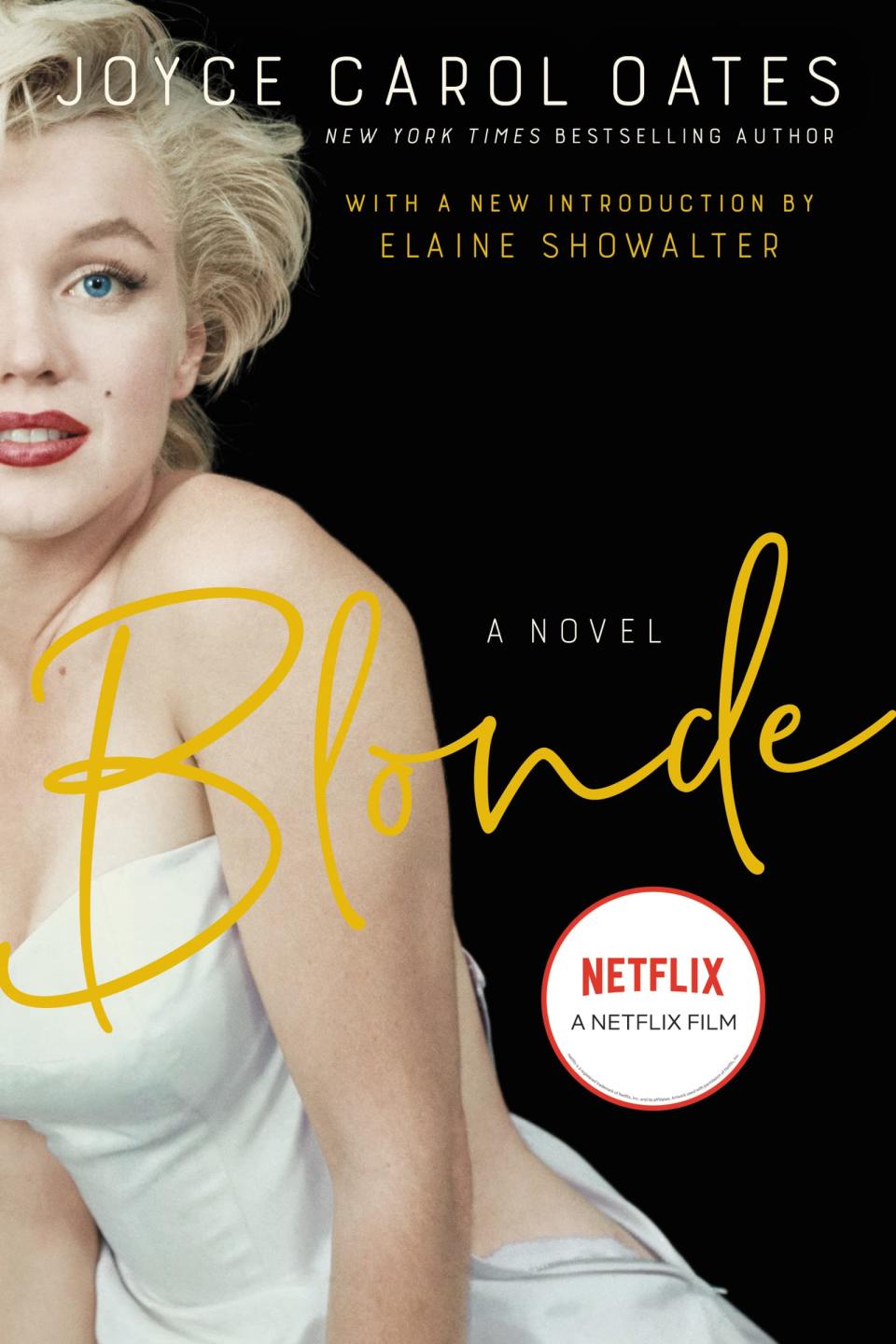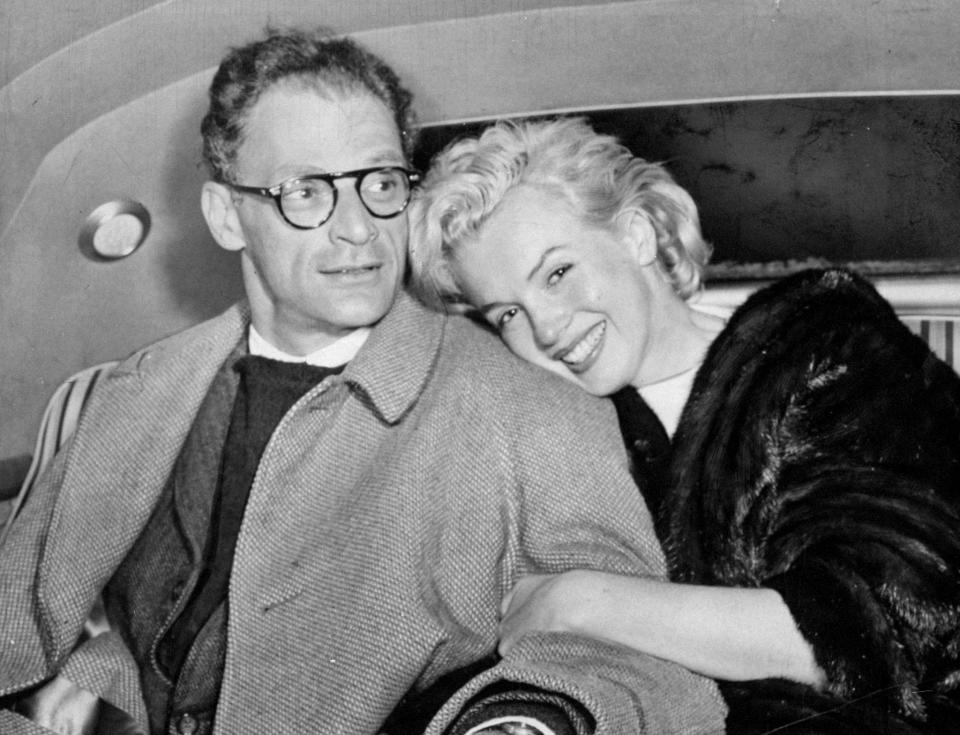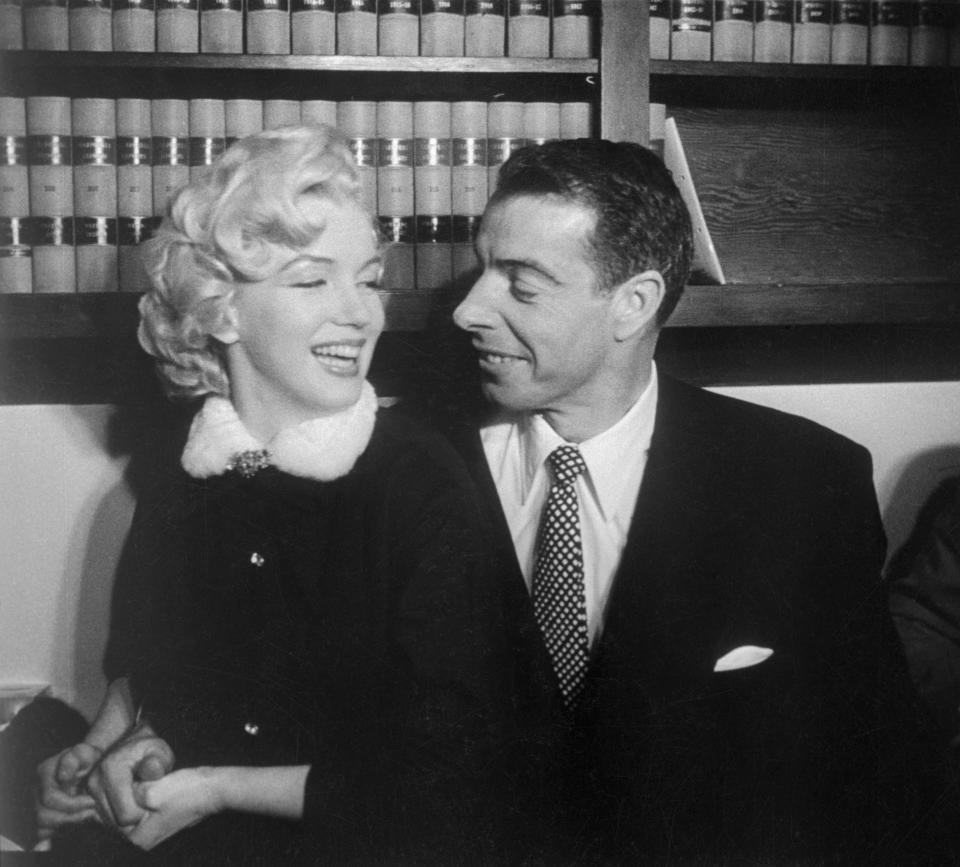Marilyn Monroe Had 3 Husbands—Why She Divorced Each of Them & What They Think of Her Now

- Oops!Something went wrong.Please try again later.
- Oops!Something went wrong.Please try again later.
- Oops!Something went wrong.Please try again later.
- Oops!Something went wrong.Please try again later.
As one of the most famous women in the world, there’s been interest in Marilyn Monroe’s husbands—and why her marriages ended—for years.
Marilyn, whose real name was Norma Jeane Mortenson, had been married three times before her death on August 4, 1962. She was 36 years old. Marilyn was born on June 1, 1926, in Los Angeles, California. Her mother, Gladys Pearl Monroe, placed her into the foster care system when she was a child. (Marilyn never knew her father, though a 2022 test revealed that her biological father was Charles Stanley Gifford, her mother’s co-worker whom she had an affair with in 1925.) Marilyn moved from home to home throughout her childhood until her marriage to her first husband, James Dougherty, when she was 16 years old.
More from StyleCaster
This Eye Cream Provides 'Truly Impressive' Results on Profound Wrinkles--& It's 41% Off on Amazon
The "Hocus Pocus" Character You Are, According to Your Zodiac Sign
Paramedics Did CPR on Coolio For 45 Minutes Before He Died--His Cause of Death Revealed
Around that time, Marilyn also started modeling and acting. It didn’t take long for her career to take off. By 1955, Marilyn, who had divorced her her first husband, had starred in movies like Niagara, Gentlemen Prefer Blondes, How to Marry a Millionaire and her biggest box office success of her career, The Seven Year Itch. Marilyn, who had become known for her comedic “blonde bombshell” characters, went on to star in dozens of more movies, including Bus Stop, The Prince and the Showgirl and Some Like It Hot, which she won the Golden Globe Award in the Best Actress, Motion Picture – Musical or Comedy category for in 1960. Her last movie, The Misfits, premiered in 1961, a year before her death.
Since Marilyn’s death, her life has been made into several movies and documentaries, including 2011’s My Week With Marilyn (in which she was played by Michelle Williams) and 2022’s Blonde (in which she was played by Ana de Armas.) “She was very inspiring. And the more I learned about her, the more I studied, the more I understood what was going on and what she went through, the more respect I felt for her,” de Armas told Out in 2022 about what inspired her about Marilyn. “Just so much more empathy, and understanding, and self-evaluation of everything as a woman in the industry, and same age [as me], same everything. A lot of things I didn’t even think we had in common.”
Click here to read the full article.
But back to Marilyn Monroe’s husbands. So who were Marilyn Monroe’s husbands and why did she divorce them? Read on for what we know about Marilyn Monroe’s husbands and her three marriages before her death.

Blonde by Joyce Carol Oates
Buy: ‘Blonde’ by Joyce Carol Oates $13.49
Who were Marilyn Monroe’s husbands?
Who were Marilyn Monroe’s husbands? Read on for what to know about Marilyn Monroe’s first, second and third husbands.
Arthur Miller (1956 – 1961)

Marilyn Monroe’s third husband was Arthur Miller, a playwright. Marilyn and Arthur started dating in 1955 after her divorce from her second husband, Joe DiMaggio, and her relationship with actor Marlon Brando. Marilyn and Arthur were introduced to each other by director Elia Kazan. Marilyn and Arthur’s relationship became more serious in October 1955 after her divorce from Joe was finalized and Arthur separated from his wife, Mary Grace Slattery. 20th Century Fox, however, disapproved of the romance and encouraged Marilyn to end it, as Arthur was being investigated at the time by the Federal Bureau of Investigation for his association with communism. He had also been subpoenaed at the time by the House Un-American Activities Committee. Marilyn and Arthur’s relationship also led the FBI to open an investigation into her. The relationship also led to negative press for Marilyn at the time, with columnist Walter Winchell describing the romance as: “America’s best-known blonde moving picture star is now the darling of the left-wing intelligentsia.”
Despite the criticism, Marilyn and Arthur married at in the Westchester County Court in White Plains, New York on June 29, 1956. Marilyn, who converted to Judaism to marry Arthur, and Arthur also had a Jewish wedding two days later at the home of Arthur’s agent, Kay Brown, in Waccabuc, New York. In 1957, Marilyn became pregnant with her first child with Arthur but had a miscarriage a year later due to her health issues with endometriosis. In 1960, Marilyn was cast in the movie The Misfits, which Arthur wrote, in which she played a recently divorced woman who became friends with three aging cowboys. The movie put a strain on Marilyn and Arthur’s marriage, as Marilyn didn’t like that Arthur partly based the role on her life and that he would re-write scenes the night before filming. Around that time, Arthur also had an affair with the movie’s photoghrapher, Inge Morath.
After The Misfits finished filming, Marilyn and Arthur separated. She obtained a divorce in Mexico in 1961. Less than two years later, Marilyn was found dead at the age of 36. In an interview on 60 Minutes in 2012, Arthur recalled his final years of marriage with Marilyn, who was struggling with depression and had suffered from multiple miscarriages. “I guess to be frank about it, I was taking care of her. I was trying to keep her afloat,” he said. “She was a super-sensitive instrument, and that’s exciting to be around until it starts to self-destruct.” When asked if his marriage to Marilyn was “doomed” from the start, Arthur told CBS News, “I didn’t know it was doomed, but I certainly felt it had a good chance to be.”
Joe DiMaggio (1954 – 1955)

Marilyn Monroe’s second husband was Joe DiMaggio, a baseball player. Marilyn and Joe, a retired New York Yankees player who had the nickname “The Yankee Clipper,” started dating in 1952. They married on January 14, 1954, at the San Francisco City Hall. After their wedding, they drove down to San Luis Obispo, California, before they continued their honeymoon at Idyllwild, California, where they stayed at Marilyn’s lawyer, Lloyd Wright’s mountain lodge.
Marilyn filed for divorce from Joe in October 1954 after nine months of marriage. The divorce came after Marilyn starred in the 1954 movie, The Seven Year Itch, in which she played a woman who was the object of her married neighbor’s sexual fantasies. To generate publicity for the movie, 20th Century Fox filmed a scene where Marilyn stood on a subway grate as air blew up the skirt of her white dress on Lexington Avenue in Manhattan, New York. The shoot lasted for a few hours and attracted more than 2,000 people who watched as it was filmed. The scene went on to become one of Marilyn’s most famous on-screen moments, as well as led The Seven Year Itch to become one of the biggest blockbuster releases in 1955. The scene, which put Marilyn on the front pages of newspapers and magazines across the world, however, marked the start of the end of her marriage to Joe, who was infuriated by the publicity stunt. Marilyn also previously described Joe as jealous, controlling and physically abusive. Marilyn, who dated actor Marlon Brando and playwright Arthur Miller after her divorce from Joe, made amends with Joe in 1961 after she underwent a cholecystectomy for her endometriosis and spent four weeks hospitalized for depression. After her health issues, Marilyn, who was dating Joe’s friend Frank Sinatra at the time, and Joe rekindled their friendship.
In his 2017 book, Dinner with DiMaggio: Memories of An American Hero, Joe’s friend, Dr. Rock Positano, revealed Joe’s perspective on his relationship with Marilyn. “Joe was very honored and privileged to have Marilyn Monroe as his wife, which is why he was so fiercely protective of her,” Rock told People in 2017. “He felt that she was very vulnerable and very sweet and that it was very easy for people to take advantage of her.” In the book, Rock also recalled how Joe described his first time having sex with Marilyn. “‘When we got together in the bedroom, it was like the gods were fighting; there were thunderclouds and lightning above us,’” Rock recalled Joe telling him. Rock also described Joe as a “renaissance man” in the book who was drawn to Marilyn for her talent. “He had an unbelievable eye for movies … He had a tremendous amount of respect for Marilyn because she was a really great actress,” Rock said. He continued to People, “The love he had with Marilyn — he was this gentleman [type]. That’s why American women would be in love with Joe DiMaggio today. He had a nurturing, caring way about him.”
In the end, however, Rock recalled an archbishop telling Joe that he shouldn’t marry Marilyn. “This isn’t the type of woman who gives people moral values,” Rock recalled the archbishop saying, to which Joe responded, “‘No one is going to tell me who to love and who to marry.'” As for why Joe and Marilyn divorced, Rock wrote in the book, “From Joe’s point of view, they didn’t stay married because Marilyn was not able to have children. It was as simple as that. It was not about the published reports of jealousy and not wanting to take a back seat to her fame. Joe wanted kids with Marilyn, and Marilyn wanted to reward him with a family. In Italian terms, sex meant kids. Great sex meant great kids. Marilyn gave goddess sex, but no kids.” (Monroe, for her part, cited “mental cruelty” for the reason behind the split.)
James Dougherty (1942 – 1946)

Marilyn Monroe’s first husband was James Dougherty, a factory worker. Marilyn, who was placed into the foster care system when she was a child, was living in the Van Nuys neighborhood of Los Angeles with her mother’s friend, Grace Goddard, and her husband, Doc Goddard, at the time she met James, who was their neighbor’s son. When she was in high school, the company that employed Doc, who sexually abused her and moved her to an orphanage for a time, relocated him to West Virginia. Child production laws in California at the time prevented Doc and Grace from moving Marilyn out of the state, which would have forced her to return to the orphanage. As a solution, Marilyn married James on June 19, 1942, when she was 16 at the time and he was 21. “They wanted to move back to [West] Virginia, and they couldn’t take Norma Jean,” James said in a 1990 interview. with the United Press International. “She would have gone back to an orphanage or another foster home, so her foster mother suggested I marry her.” He continued, “I thought she was awful young, but I took her to a dance. She was a pretty mature girl and physically she was mature, of course. We talked and we got on pretty good.” Though Marilyn and James married for convenience, he confirmed to the publication at the time that the two were “in love.” “We decided to get married to prevent her from going back to a foster home,” he said. “But we were in love.”
Soon after her marriage to James, Marilyn dropped out of high school at Van Nuys High School and became a housewife. “She was just a housewife,” James told the United International Press in 1990. “We would go down to the beach on weekends, and have luaus on Saturday night. She loved it over there. It was like being on a honeymoon for a year.” Around this time, James also enlisted in the United States Merchant Marine and Santa Catalina Island, where Marilyn—who once described that she was “dying of boredom” while married to James,—moved to with him. Soon after, James was shipped to the Pacific where he remained for the next two years. During that time, Marilyn lived with James’ parents and started a job at the Radioplane Company, a munitions factory in Los Angeles. While at her job, Marilyn met David Conorover, a photographer who was sent by the .S. Army Air Forces’ First Motion Picture Unit to shoot photos of female workers at the factory to boost the morale of soldiers. The shoot led Marilyn to quit her job at the factory and start modeling for David and other photographers, despite James’ protests. Marilyn also signed a contract with the Blue Book Model Agency and started modeling for pin-up magazines. To make her more employable, Marilyn also straightened her hair and dyed it blonde. She soon became one of the Blue Book Model Agency’s most popular models, appearing in 33 magazine covers in a year.
As her modeling success continued, Marilyn also signed a contract with an acting agency, which led to an interview and screen test with 20th Century Fox. Though the studio was unenthusiastic about Marilyn, executive Darryl F. Zanuck signed her to a six-month contract so their rival studios RKO Pictures couldn’t sign her. Around this time, executive Ben Lyon also gave Marilyn the stage name “Marilyn Monroe,” which was inspired by Marilyn’s mother’s maiden name, Monroe,” and the Broadway star, Marilyn Miller. In 1946, Marilyn divorced James—who was against her modeling and acting career—after four years of marriage.
In an interview with the United Press International in 1990, 28 years after Marilyn’s death, James claimed that he “never knew” Marilyn and only knew her as Norma Jean. “I never knew Marilyn Monroe, and I don’t claim to have any insights to her to this day,” he said. “I knew and loved Norma Jean.” In a 2004 interview with the Boston Globe, James, who Marilyn nicknamed “Jimmie,” described his ex-wife as “feisty, blunt and sometimes bawdy raconteur.” He added, “We loved each other madly. I felt like the luckiest guy in the world.”
James also told the Associate Press in 2002 about how Marilyn filed for divorce in Las Vegas while he was away with the marines. “I was on a ship in the Yangtze River getting ready to go into Shanghai when I was served with divorce papers,” he said. He claimed to the United Press International that Marilyn had to divorce her because of her contract with 20th Century Fox. “She wanted to sign a contract with [20th Century] Fox and it said she couldn’t be married—they didn’t want a pregnant starlet,” he said. “When I went back to see her, I tried to talk her out of it. She wanted me to be there—she just wanted us to keep on and not be married for the contract. I couldn’t do that.”
Soon after his divorce from Marilyn, James went on to marry a woman named Pat, who didn’t allow him to see Marilyn’s movies because she didn’t want to hear about his ex-wife. “[She felt] like she had to compete with Norma Jean, even though she was far ahead because she gave me three beautiful children,” he said. “[During my second marriage], I destroyed all my letters from Norma Jean—hundreds of them. I don’t need them for a memory, but I probably could have built a house for what they are worth.”
James learned of Marilyn’s death from a co-worker at the Los Angeles Police Department who called im and said,
Dougherty later recalled that a co-worker at the Los Angeles Police Department called him on the phone and said: “Your ex-wife is dead.” He told the Associate Press in 2002, “I had almost been expecting it. Fame was injurious to her. She was too gentle to be an actress. She wasn’t tough enough for Hollywood. And once someone starts getting into pills—uppers and downers, the way she was—people can go downhill. They can’t sleep, so they take more and more pills.”
Blonde is available to stream on Netflix.

My Story by Marilyn Monroe
Buy: ‘My Story’ by Marilyn Monroe $19.49
For more about Marilyn Monroe, read her 1974 autobiography, My Story. Written in her own words, My Story takes readers through Marilyn’s life, from her childhood as an unwanted orphan to her rise as a movie star and sex symbol. The intimate book also tells all of Marilyn’s three marriages (including with her controversial second husband, Yankee Clipper Joe DiMaggio) and the vision she had of herself as “the kind of girl they found dead in the hall bedroom with an empty bottle of sleeping pills in her hand,” according to the publisher’s description. Illustrated with rare photos of Marilyn throughout her life, My Story tells the real story of how Marilyn became the American Hollywood icon the world knows and loves today.
Our mission at STYLECASTER is to bring style to the people, and we only feature products we think you’ll love as much as we do. Please note that if you purchase something by clicking on a link within this story, we may receive a small commission of the sale.
Best of StyleCaster


